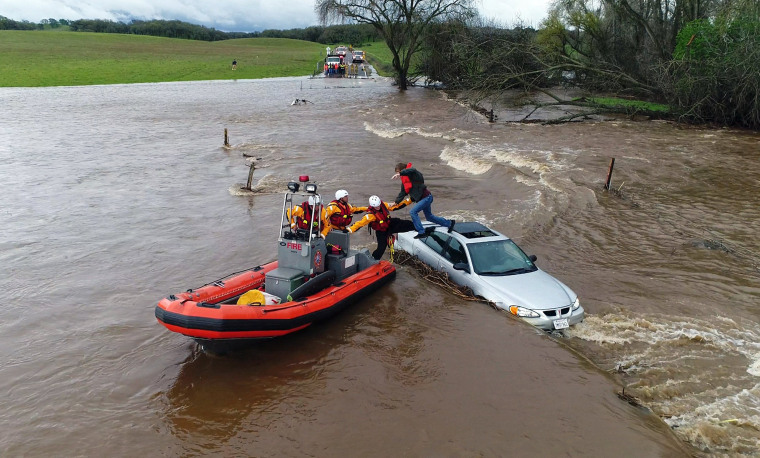Parts of Southern California saw enough rain to drown a can of Coke as a system tapping an atmospheric river of moisture struck the region this week. But the hoped-for March miracle of enough precipitation to reach a normal year's rainfall looks unlikely.
Some forecasters went so far as to conclude that the rainy season is all but over.
Despite flooding in some areas, the United States Drought Monitor still categorized most of Southern California as under moderate or severe drought.
Storm totals for downtown Los Angeles, 1.02 inches of rain as of late Thursday, contributed little to the goal of a normal wet season — 14.93 inches — said Bonnie Bartling, a weather specialist with the National Weather Service. L.A.'s rain year — Oct. 1 through Sept. 30 — has so far produced 4.45 inches, and experts see little more en route as the driest months approach.
"It looks like a one-hit wonder here," said Dave Samuel, a senior meteorologist at private forecaster AccuWeather. "This looks like our last big opportunity for widespread rainfall. We’re looking at building heat and dry conditions across Southern California."
The two-day storm produced rain at nearly a half-inch per hour in parts of Santa Barbara County, where residents in the Thomas Fire burn zone were under temporary evacuation orders because authorities feared another catastrophic mudslide was possible. Parts of Ventura County saw more than 5 inches of rain. Mountains near Las Vegas saw nearly 5 inches, according to the service. A few communities near California's Bay Area office saw nearly 10 inches of precipitation this week.
Still, it was too little for the vast majority of the Golden State’s population experiencing another year of parched conditions following a record, six-year stretch of historic drought that officially ended with a pronouncement from Gov. Jerry Brown last year.
Even the Bay Area, which is officially far from drought status, is at only 66 percent of normal rainfall, National Weather Service San Francisco lead forecaster Duane Dykema said. Much of Northern California is "abnormally dry," according to the drought monitor, and Sierra Nevada snowpack and precipitation — the supply closet of California’s water systems — is only a bit more than half of normal, according to the state Department of Water Resources.
"We’re certainly in a much better situation then we were six weeks ago," says Stanford earth systems science professor Noah Diffenbaugh. "We’ve gotten a lot of help from recent storms, but the largest fractions of California are still officially in drought conditions."
Luckily, enough rain and snow fell in parts of California during the last rain season to ensure that drinking water supplies are ample, the Diffenbaugh said. "The most severe drought in California history ended with extremely wet conditions."
But the long-term outlook isn’t good.
"We could see a lot of hot, dry weather in April, May and June," said Samuel of AccuWeather, which runs models and historical statistics to create a long-term forecast. "Our spring forecast is for early summer weather. It could turn out to be record heat."
The region has been under the influence of a La Niña weather phase, which generally coincides with drier conditions in Southern California, as a opposed to the typically wetter weather during an El Niño year.
But academics say even the predictability of those systems are changing as a result of global warming. University of California Irvine earth system science professor Jin-Yi Yu wrote in a recent research paper that arctic warming and sea ice losses have made El Niño less reliable as a weather beacon. The 2016 event expected by some to become a "Godzilla El Niño" never brought the expected torrents to the region.
Marty Ralph, a research meteorologist at the Scripps Institution of Oceanography in La Jolla explained, "We had that big, strong El Niño a few years ago but, in terms of rain, it didn’t work out that way."
If El Niño years become less the reliable drought fighters they once were, Stanford's Diffenbaugh said, Californians will see even more summer-like days and even fewer rainy ones.

